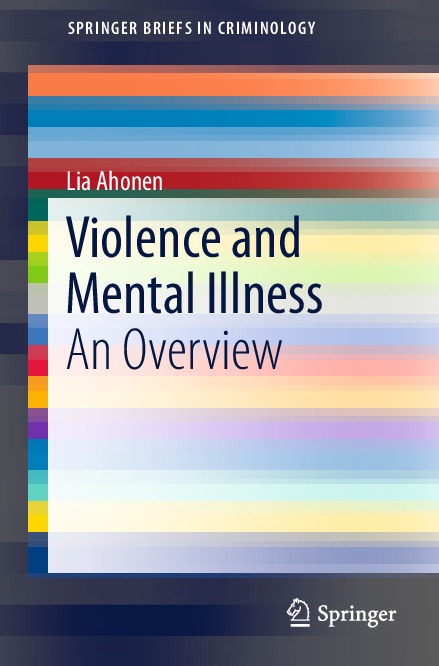File #2748: "2019_Book_ViolenceAndMentalIllness.pdf"
Testo
1|Acknowledgements|7
1|Contents|8
1|1 Introduction: Violence and Mental Illness in Context|11
2|1.1 Violence in the Twenty-First Century|12
2|1.2 Gender, Race, and Age Differences|13
2|1.3 Different Categories of Violence|14
2|1.4 Mental Illness|14
2|1.5 Spectacular Events and Mental Illness|15
2|1.6 Methodological Challenges|16
2|1.7 Why We Need This Book|17
2|References|18
1|2 Crazy, Mad, Insane, or Mentally Ill?|20
2|2.1 Why Are Clear Definitions Important?|20
2|2.2 Theoretical Underpinnings of Moral Development and Societal Values|21
2|2.3 A Positive Example of Interaction Rituals|23
2|2.4 A Negative Example of Interaction Rituals|24
2|2.5 Core Concepts|25
2|References|28
1|3 Public Perceptions and Experts’ Opinions: Causes, Correlates, and Prevention|30
2|3.1 Background|31
2|3.2 Reporting of Mental Illness to Prevent Gun Violence|32
2|3.3 The Present Study|33
2|3.4 Results|35
2|3.5 Conclusions|39
2|3.6 Research Needs|40
2|3.7 Some Limitations and Strengths of the Data Presented|41
2|References|42
1|4 The Association Between Mental Illness and Violence|45
2|4.1 Attributable Risk|46
2|4.2 A Few Notes on the Methodology of the Study|48
2|4.3 The Results|48
2|4.4 What Is the Clinical Relevance of the Conclusions in This Chapter?|52
2|References|53
1|5 Psychiatric Symptoms and Behaviors in Adolescence that Are Associated with Violence|55
2|5.1 Developmental Disorders or Delays|56
2|5.2 Hyperactivity and Attention Deficits|57
2|5.3 Externalizing Behavior and Conduct Disorder|58
2|5.4 Contextual Factors that Impact Psychiatric Symptoms in Childhood and Adolescence|60
2|References|62
1|6 Special Populations: Gender, Race, and Incarcerated Individuals|64
2|6.1 The Role of Gender in Mental Illness and Violence|65
2|6.2 The Role of Race/Ethnicity in Mental Illness and Violence|67
2|6.3 Mental Illness and Violence in Incarcerated Populations|68
2|References|71
1|7 Victimization and Suicide|74
2|7.1 What Is the Relationship Between Committing Violence and Becoming a Victim of Violence?|75
2|7.2 Risk Factors for Violent Offending and Victimization in Mentally Ill People|75
2|7.3 Suicide and Mental Illness|76
2|References|78
1|8 Conclusions and Implications|80
2|8.1 Violence as a Public Health Concern|81
2|8.2 Stigma and Social Interaction|81
2|8.3 Public Perceptions and the Discrepancy Between Evidence and Daily Media Reporting|82
2|8.4 The Empirical Relationship Between Mental Disorder and Violence|82
2|8.5 Psychiatric Symptoms and Diagnoses in Childhood and Adolescence|83
2|8.6 Gender, Race, and Incarcerated Populations|84
2|8.7 Victimization of Mentally Ill and Suicide|84
2|8.8 Implications and Recommendations|85
2|8.9 For Policy-Making|86
2|8.10 For Justice System Practices|87
2|8.11 Concluding Remarks|88
2|References|89
1|Index|90
1|Contents|8
1|1 Introduction: Violence and Mental Illness in Context|11
2|1.1 Violence in the Twenty-First Century|12
2|1.2 Gender, Race, and Age Differences|13
2|1.3 Different Categories of Violence|14
2|1.4 Mental Illness|14
2|1.5 Spectacular Events and Mental Illness|15
2|1.6 Methodological Challenges|16
2|1.7 Why We Need This Book|17
2|References|18
1|2 Crazy, Mad, Insane, or Mentally Ill?|20
2|2.1 Why Are Clear Definitions Important?|20
2|2.2 Theoretical Underpinnings of Moral Development and Societal Values|21
2|2.3 A Positive Example of Interaction Rituals|23
2|2.4 A Negative Example of Interaction Rituals|24
2|2.5 Core Concepts|25
2|References|28
1|3 Public Perceptions and Experts’ Opinions: Causes, Correlates, and Prevention|30
2|3.1 Background|31
2|3.2 Reporting of Mental Illness to Prevent Gun Violence|32
2|3.3 The Present Study|33
2|3.4 Results|35
2|3.5 Conclusions|39
2|3.6 Research Needs|40
2|3.7 Some Limitations and Strengths of the Data Presented|41
2|References|42
1|4 The Association Between Mental Illness and Violence|45
2|4.1 Attributable Risk|46
2|4.2 A Few Notes on the Methodology of the Study|48
2|4.3 The Results|48
2|4.4 What Is the Clinical Relevance of the Conclusions in This Chapter?|52
2|References|53
1|5 Psychiatric Symptoms and Behaviors in Adolescence that Are Associated with Violence|55
2|5.1 Developmental Disorders or Delays|56
2|5.2 Hyperactivity and Attention Deficits|57
2|5.3 Externalizing Behavior and Conduct Disorder|58
2|5.4 Contextual Factors that Impact Psychiatric Symptoms in Childhood and Adolescence|60
2|References|62
1|6 Special Populations: Gender, Race, and Incarcerated Individuals|64
2|6.1 The Role of Gender in Mental Illness and Violence|65
2|6.2 The Role of Race/Ethnicity in Mental Illness and Violence|67
2|6.3 Mental Illness and Violence in Incarcerated Populations|68
2|References|71
1|7 Victimization and Suicide|74
2|7.1 What Is the Relationship Between Committing Violence and Becoming a Victim of Violence?|75
2|7.2 Risk Factors for Violent Offending and Victimization in Mentally Ill People|75
2|7.3 Suicide and Mental Illness|76
2|References|78
1|8 Conclusions and Implications|80
2|8.1 Violence as a Public Health Concern|81
2|8.2 Stigma and Social Interaction|81
2|8.3 Public Perceptions and the Discrepancy Between Evidence and Daily Media Reporting|82
2|8.4 The Empirical Relationship Between Mental Disorder and Violence|82
2|8.5 Psychiatric Symptoms and Diagnoses in Childhood and Adolescence|83
2|8.6 Gender, Race, and Incarcerated Populations|84
2|8.7 Victimization of Mentally Ill and Suicide|84
2|8.8 Implications and Recommendations|85
2|8.9 For Policy-Making|86
2|8.10 For Justice System Practices|87
2|8.11 Concluding Remarks|88
2|References|89
1|Index|90

